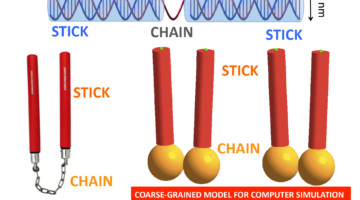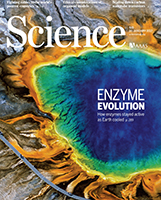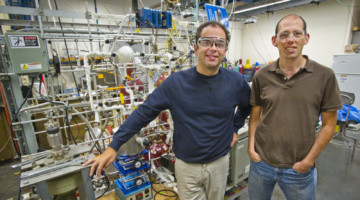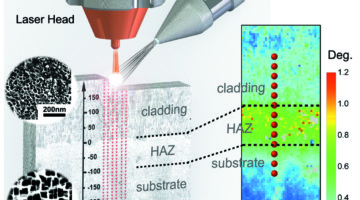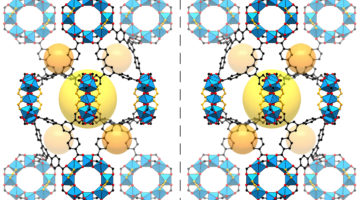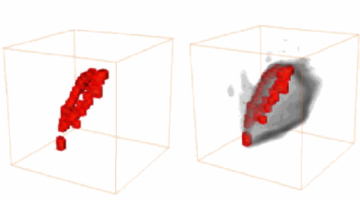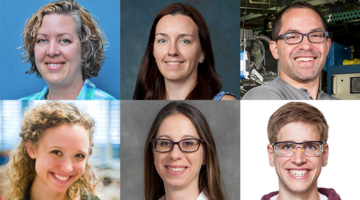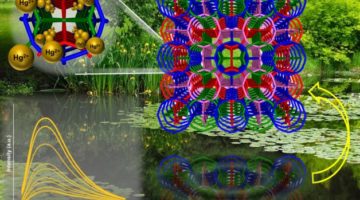Researchers designed DNA sequences that self-assemble into a nanoparticle about 50 nm long, composed of two double-stranded DNA duplexes linked together by a single-stranded DNA filament. The nanoparticle resembles nunchaku—a traditional weapon of several martial arts—but 30 million times smaller. Read more »
Evolutionary drivers of thermoadaptation in enzyme catalysis
With early life likely to have existed in a hot environment, enzymes had to cope with an inherent drop in catalytic speed caused by lowered temperature. Here, researchers characterize the molecular mechanisms underlying thermoadaptation of enzyme catalysis in adenylate kinase using ancestral sequence reconstruction spanning 3 billion years of evolution. Read more »
Chemistry on the Edge: Study Pinpoints Most Active Areas of Reactions on Nanoscale Particles
Experiments confirm that structural defects at the periphery are key in catalyst function. The SINS study is an important step in chronicling how the atomic structure of nanoparticles impacts their function as catalysts in chemical reactions. Read more »
Exploring the Structure of Aqueous Solutions with SALSA
Researchers have published a series of papers that open up the possibility of probing hydrogen bonds in aqueous solutions by combining x-ray emission spectroscopy and resonant inelastic soft x-ray scattering, using the specialized Solid and Liquid Spectroscopic Analysis (SALSA) endstation at Beamline 8.0.1. Read more »
X-Rays Help Evaluate Quality of 3D-Printed Repairs
Laser 3D printing is a promising way to repair machine parts (such as jet-engine turbine blades) made of single-crystal superalloys. But microstructural inhomogeneities created by the high-power laser are a major reliability concern, so researchers employed x-ray Laue microdiffraction to probe the microstructure. Read more »
ALS in the News (Dec 2016)
- 7 Imaging Tools Pushing Science Forward
- Finding Diamonds in the Rough
- CRISPR Pioneers Runners Up for Time Magazine’s Person of the Year
- Nanogeometry
- Glowing Crystals Can Detect, Cleanse Contaminated Drinking Water
- Scientists Trace ‘Poisoning’ in Chemical Reactions to the Atomic Scale
- X-Rays Capture Unprecedented Images of Photosynthesis in Action
- Five Berkeley Lab Scientists Named AAAS Fellows
- 3-D Imaging Technique Maps Migration of DNA-carrying Material at the Center of Cells
- Molecular structure in Zika virus leads to potentially disease-causing RNAs
- Solar Cells Get Boost with Integration of Water-Splitting Catalyst onto Semiconductor
- Berkeley Lab Takes Home Five R&D 100 Awards for Environmental, Battery, and X-ray Technologies
- Lehigh scientists fabricate a new class of crystalline solid
- Miquel Salmeron Wins 2016 Berkeley Lab Prize — Lifetime Achievement Award
A New Way to Determine the 3D Structure of Molecules
Researchers have created a sort of nanoscale display case that enables new atomic-scale views of hard-to-study chemical and biological samples. The work could help to reveal new structural details for a range of challenging molecules by stabilizing them inside sturdy structures known as metal-organic frameworks (MOFs). Read more »![]()
![]()
3D Visualization of the Behavior of Grease Additives
Lubricants help keep civilization running smoothly, but is there room for improvement? With the goal of increasing the life span and lowering the costs of all kinds of mechanical and biological systems, researchers used x-ray microtomography to visualize the behavior of grease additives under working conditions. Read more »
Meet the New UEC Members
The results of the ALS Users’ Executive Committee (UEC) election are in, and six new members have been chosen, including a new student representative. They will each serve on the committee for three years (two years for the student representative), starting on January 1, 2017. Read more »
Glowing Crystals Can Detect, Cleanse Contaminated Drinking Water
Tiny, glowing crystals designed to detect and capture heavy-metal toxins such as lead and mercury could prove to be a powerful new tool in locating and cleaning up contaminated water sources. The crystals function like miniature, reusable sensors and traps, and are known as luminescent metal-organic frameworks, or LMOFs. Read more »
- « Previous Page
- 1
- …
- 70
- 71
- 72
- 73
- 74
- …
- 83
- Next Page »
